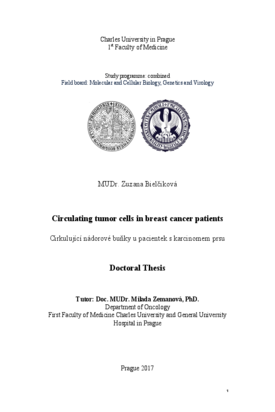Circulating tumor cells in breast cancer patients
Cirkulující nádorové buňky u pacientek s karcinomem prsu.
dissertation thesis (DEFENDED)

View/
Permanent link
http://hdl.handle.net/20.500.11956/94038Identifiers
Study Information System: 60770
CU Caralogue: 990021660380106986
Collections
- Kvalifikační práce [4639]
Author
Advisor
Referee
Gürlich, Robert
Fínek, Jindřich
Faculty / Institute
First Faculty of Medicine
Discipline
-
Department
Department of Oncology First Faculty of Medicine and General University Hospital in Prague
Date of defense
19. 9. 2017
Publisher
Univerzita Karlova, 1. lékařská fakultaLanguage
English
Grade
Pass
Keywords (Czech)
minimal residual disease, liquid biopsy, circulating tumor cells, breast cancer, prognostic marker, predictive markerKeywords (English)
minimal residual disease, liquid biopsy, circulating tumor cells, breast cancer, prognostic marker, predictive markerCirkulující nádorové buňky (CTCs) představují systémovou fázi lokalizované maligní nemoci. Jejich identifikace a odlišení od okolních krevních elementů, zejména leukocytů je možné pomocí fyzikálních (např. hustota či velikost) a/nebo biologických vlastností CTCs (např. exprese epitelových znaků jako jsou EpCAM nebo cytokeratiny) a je dále obvykle doplněna o typizaci pomocí barvení či RT-PCR. Odlišení nemocných s vysokým rizikem relapsu nemoci je klíčovým bodem pro indikaci adjuvantní chemoterapie. CTCs jsou silným prognostickým markerem jak u primárního, tak metastatického karcinomu prsu (BC). Víme také, že cirkulující (diseminované) nádorové buňky jsou markerem nezávislým na standardních prognostických parametrech. Testování CTCs, neboli tzv. tekutá biopsie může být přínosná nejen pro predikci recidivy nemoci, ale také pro predikci léčebné odpovědi. Klinické využití CTCs musí být doloženo klinickými studiemi. Monitorace CTCs v čase může přiblížit mechanizmy rezistence nemoci a pomoci odhalit terče pro potencionální terapeutické cílení. Cílem mojí práce byla jednak detekce a stanovení úrovně CTCs pozitivity u nemocných s BC v různých fázích terapie (neo/adjuvantní či paliativní), jednak charakterizace CTCs pomocí tumor-asociovaných genů a genů spojených s chemorezistencí, a to zejména u nemocných s...
Circulating tumor cells (CTCs) represent a systemic phase of the localised cancer disease. They can be distinguished and enriched from the peripheral blood and so from the surrounding leukocytes by either physical properties (e.g., density and size) or biological properties (e.g., expression of epithelial proteins such as EpCAM or cytokeratins) and are usually further characterized by immunostaining or RT-PCR assays. Selecting patients with the risk of disease relaps at the time of diagnosis is crucial for clinicians in deciding who should, and who should not, receive adjuvant chemotherapy. We know that CTCs are strong prognostic factor in patients with metastatic as well as localized breast cancer (BC). It is also known that the prognostic power of circulating tumor cells in women with BC is independent from the standard prognostic indicators. Testing of CTCs known recently as "liquid biopsy" could be informative not only as predictor of the disease relapse, but also as the predictor of therapy effectiveness. The clinical use of CTCs must be strictly encouraged by clinical trials results. Monitoring of CTCs in time could zoom in the mechanism of therapy resistance and/or may provide the identification of new druggable targets. The purpose of my work was therefore to assess the CTCs positivity rate...
